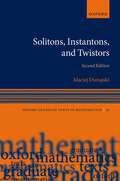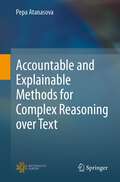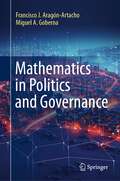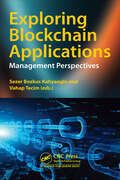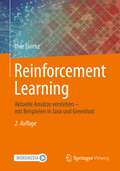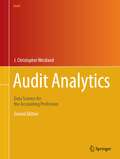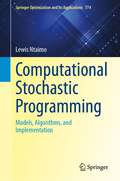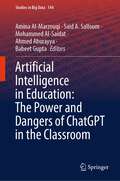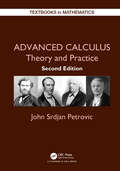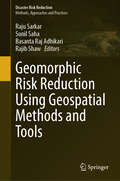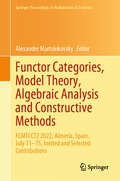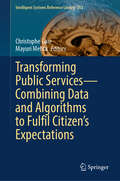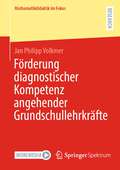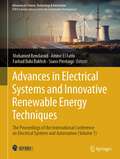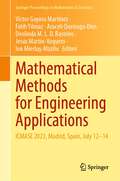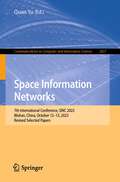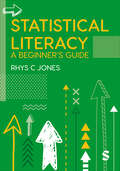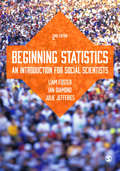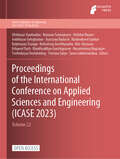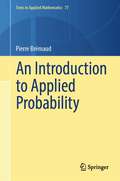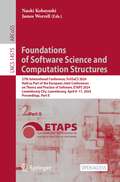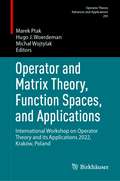- Table View
- List View
Solitons, Instantons, and Twistors (Oxford Graduate Texts in Mathematics)
by Maciej DunajskiMost nonlinear differential equations arising in natural sciences admit chaotic behaviour and cannot be solved analytically. Integrable systems lie on the other extreme. They possess regular, stable, and well-behaved solutions known as solitons and instantons. These solutions play important roles in pure and applied mathematics as well as in theoretical physics where they describe configurations topologically different from vacuum. While integrable equations in lower space-time dimensions can be solved using the inverse scattering transform, the higher-dimensional examples of anti-self-dual Yang-Mills and Einstein equations require twistor theory. Both techniques rely on an ability to represent nonlinear equations as compatibility conditions for overdetermined systems of linear differential equations. The book provides a self-contained and accessible introduction to the subject. It starts with an introduction to integrability of ordinary and partial differential equations. Subsequent chapters explore symmetry analysis, gauge theory, vortices, gravitational instantons, twistor transforms, and anti-self-duality equations. The three appendices cover basic differential geometry, complex manifold theory, and the exterior differential system.
Accountable and Explainable Methods for Complex Reasoning over Text
by Pepa AtanasovaThis thesis presents research that expands the collective knowledge in the areas of accountability and transparency of machine learning (ML) models developed for complex reasoning tasks over text. In particular, the presented results facilitate the analysis of the reasons behind the outputs of ML models and assist in detecting and correcting for potential harms. It presents two new methods for accountable ML models; advances the state of the art with methods generating textual explanations that are further improved to be fluent, easy to read, and to contain logically connected multi-chain arguments; and makes substantial contributions in the area of diagnostics for explainability approaches. All results are empirically tested on complex reasoning tasks over text, including fact checking, question answering, and natural language inference. This book is a revised version of the PhD dissertation written by the author to receive her PhD from the Faculty of Science, University ofCopenhagen, Denmark. In 2023, it won the Informatics Europe Best Dissertation Award, granted to the most outstanding European PhD thesis in the field of computer science.
Espaces de Berkovich Globaux: Catégorie, Topologie, Cohomologie (Progress in Mathematics #353)
by Thibaud Lemanissier Jérôme PoineauCet ouvrage propose une contribution aux fondements de la théorie des espaces de Berkovich globaux. Cette approche récente à la géométrie analytique, qui mêle les théories classiques des espaces analytiques complexes et p-adiques, fournit un cadre géométrique naturel pour plusieurs théories arithmétiques, telle que la théorie d’Arakelov. Les auteurs suivent trois axes principaux, inexplorés au-delà de la dimension 1 : catégorie, topologie et cohomologie. En particulier, ils introduisent une notion de domaine affinoïde surconvergent, pour lequel sont valables les analogues des théorèmes de Tate et de Kiehl.This monograph contributes to the foundations of the theory of global Berkovich spaces. This recent approach of analytic geometry, which blends the known theories of complex and p-adic analytic spaces, provides a natural geometric framework for several arithmetic theories, such as Arakelov geometry. The authors focus on three main themes which have yet to be investigated beyond dimension 1 : category, topology, and cohomology. In particular, they introduce a notion of overconvergent affinoid domain where the analogues of Tate's and Kiehl's theorems hold.
Mathematics in Politics and Governance
by Francisco J. Aragón-Artacho Miguel A. GobernaThis book presents the mathematical tools that politicians use to make rational decisions about health, education, culture, economy, finance, transportation, and national defense for their citizens. The selection of topics addressed is based on the experiences of four veteran politicians who have doctorates or master’s degrees in mathematics. The exposition also considers the mathematical tools used by politicians to capture votes or optimize their impact on the design of electoral districts, i.e., gerrymandering, without forgetting the mathematics applied to parliamentary activity and political science.Aimed at a general educated readership, a basic knowledge of mathematics is the only requisite to understanding most of the book. Certain sections, denoted in the book with a star, contain more advanced material and require some knowledge of undergraduate math. A later chapter is dedicated to applications and techniques of machine learning and the final chapter discusses a variety of cases where political decisions have affected mathematical development. Readers gravitating towards this book are those who are curious about the history of mathematics, including optimizers and mathematicians who would like to learn more about the historical roots of their discipline. There will also be strong appeal to mathematically-oriented economists, political scientists, and people generally interested in mathematics.Mathematics is – or it should be! – an important part of our culture. The impact of mathematics is sometimes silent, but a powerful one. The authors of this book did an incredible work in digging out areas of mathematical reasoning that pervades social and political life. Reading this book, we will all enrich our vision of mathematics’ value for society.(Nuno Crato, Professor of Applied Mathematics, University of Lisbon, former minister of Education and Science of Portugal 2011–2015)This monograph shows in an impressive way that mathematics can be very helpful in making and evaluating political decisions and that it is indispensable in the progressive penetration of all areas of society with scientific methods. This also includes politics. Not everything in politics can be justified or related to mathematics, but politics should not be made in contradiction to mathematical truths. For me, this is a central message of this publication.(Johanna Wanka, Professor of Applied Mathematics, Merseburg University of Applied Sciences, former Minister of Education and Research, Germany 2013–2018)
Exploring Blockchain Applications: Management Perspectives
by Sezer Bozkus Kahyaoglu Vahap TecimIn this book, the development process of blockchain algorithms and examples of their applications in different sectors are explored. The opportunities and challenges of blockchain implementations that arise in making technological innovations usable in corporate structures are discussed. In this respect, the book aims to deal with both the conceptual framework and the real challenges and opportunities encountered in practice regarding the blockchain applications. It is tried to contribute to the literature by presenting practical blockchain application suggestions to the readers on a scientific basis.It is a fact that blockchain technology is considered one of the most disruptive and revolutionary innovations after the invention of the internet. Blockchain technology, which was first used for cross-border payments, is coming up with a new application area in a different sector every day. The main purpose of Blockchain-based systems is to spread the "trust" service provided by a central intermediary to machines in transactions between two parties. Thus, it removes the need for this trust from the monopoly of a single intermediary. Blockchain implementation scenarios are to establish math-based trust in an untrusted environment.While exploring the complexity of blockchain applications in different sectors, the emerging risks are also examined from a management perspective. In particular, it is aimed to be a key work that the management levels of the enterprises can benefit from in the decision-making processes.It will be seen that blockchain technologies will be used unlimitedly in design, planning, management and decision making. This book will also introduce new visions for practitioners to use different blockchain technologies and methodologies to face problems.
Exploring Blockchain Applications: Management Perspectives
In this book, the development process of blockchain algorithms and examples of their applications in different sectors are explored. The opportunities and challenges of blockchain implementations that arise in making technological innovations usable in corporate structures are discussed. In this respect, the book aims to deal with both the conceptual framework and the real challenges and opportunities encountered in practice regarding the blockchain applications. It is tried to contribute to the literature by presenting practical blockchain application suggestions to the readers on a scientific basis.It is a fact that blockchain technology is considered one of the most disruptive and revolutionary innovations after the invention of the internet. Blockchain technology, which was first used for cross-border payments, is coming up with a new application area in a different sector every day. The main purpose of Blockchain-based systems is to spread the "trust" service provided by a central intermediary to machines in transactions between two parties. Thus, it removes the need for this trust from the monopoly of a single intermediary. Blockchain implementation scenarios are to establish math-based trust in an untrusted environment.While exploring the complexity of blockchain applications in different sectors, the emerging risks are also examined from a management perspective. In particular, it is aimed to be a key work that the management levels of the enterprises can benefit from in the decision-making processes.It will be seen that blockchain technologies will be used unlimitedly in design, planning, management and decision making. This book will also introduce new visions for practitioners to use different blockchain technologies and methodologies to face problems.
Reinforcement Learning: Aktuelle Ansätze verstehen – mit Beispielen in Java und Greenfoot
by Uwe LorenzIn uralten Spielen wie Schach oder Go können sich die brillantesten Spieler verbessern, indem sie die von einer Maschine produzierten Strategien studieren. Robotische Systeme üben ihre Bewegungen selbst. In Arcade Games erreichen lernfähige Agenten innerhalb weniger Stunden übermenschliches Niveau. Wie funktionieren diese spektakulären Algorithmen des bestärkenden Lernens? Mit gut verständlichen Erklärungen und übersichtlichen Beispielen in Java und Greenfoot können Sie sich die Prinzipien des bestärkenden Lernens aneignen und in eigenen intelligenten Agenten anwenden. Greenfoot (M.Kölling, King’s College London) und das Hamster-Modell (D.Bohles, Universität Oldenburg) sind einfache, aber auch mächtige didaktische Werkzeuge, die entwickelt wurden, um Grundkonzepte der Programmierung zu vermitteln. Wir werden Figuren wie den Java-Hamster zu lernfähigen Agenten machen, die eigenständig ihre Umgebung erkunden. Die zweite Auflage enthält neue Themen wie "Genetische Algorithmen" und "Künstliche Neugier" sowie Korrekturen und Überarbeitungen.
Audit Analytics: Data Science for the Accounting Profession (Use R!)
by J. Christopher WestlandThis book, using R and RStudio, demonstrates how to render an audit opinion that is legally and statistically defensible; analyze, extract, and manipulate accounting data; build a risk assessment matrix to inform the conduct of a cost-effective audit program; and more. Today, information technology plays a pivotal role in financial control and audit: most financial data is now digitally recorded and dispersed among servers, clouds and networks over which the audited firm has no control. Additionally, a firm’s data—particularly in the case of finance, software, insurance and biotech firms—comprises most of the audited value of the firm. Financial audits are critical mechanisms for ensuring the integrity of information systems and the reporting of organizational finances. They help avoid the abuses that led to passage of legislation such as the Foreign Corrupt Practices Act (1977), and the Sarbanes-Oxley Act (2002). Audit effectiveness has declined over the past two decades, as auditor skillsets have failed to keep up with advances in information technology. Information and communication technology lie at the core of commerce today and are integrated in business processes around the world. This book is designed to meet the increasing need of audit professionals to understand information technology and the controls required to manage it. This 2nd edition includes updated code and test. Machine learning, AI, and SEC’s EDGAR data are also, improved and updated. The material included focuses on the requirements for annual Securities and Exchange Commission audits (10-K) for listed corporations. These represent the benchmark auditing procedures for specialized audits, such as internal, governmental, and attestation audits. Many examples reflect the focus of the 2024 CPA exam, and the data analytics-machine learning approach will be central to the AICPA’s programs, in the near future.
Computational Stochastic Programming: Models, Algorithms, and Implementation (Springer Optimization and Its Applications #774)
by Lewis NtaimoThis book provides a foundation in stochastic, linear, and mixed-integer programming algorithms with a focus on practical computer algorithm implementation. The purpose of this book is to provide a foundational and thorough treatment of the subject with a focus on models and algorithms and their computer implementation. The book’s most important features include a focus on both risk-neutral and risk-averse models, a variety of real-life example applications of stochastic programming, decomposition algorithms, detailed illustrative numerical examples of the models and algorithms, and an emphasis on computational experimentation. With a focus on both theory and implementation of the models and algorithms for solving practical optimization problems, this monograph is suitable for readers with fundamental knowledge of linear programming, elementary analysis, probability and statistics, and some computer programming background. Several examples of stochastic programming applications areincluded, providing numerical examples to illustrate the models and algorithms for both stochastic linear and mixed-integer programming, and showing the reader how to implement the models and algorithms using computer software.
Artificial Intelligence in Education: The Power and Dangers of ChatGPT in the Classroom (Studies in Big Data #144)
by Amina Al-Marzouqi Said A. Salloum Mohammed Al-Saidat Ahmed Aburayya Babeet GuptaThis book aims to bring together a collection of innovative and cutting-edge research that addresses the various challenges in the application and theoretical aspects of ChatGPT in education. ChatGPT is a large language model developed by OpenAI that has the ability to generate human-like text based on a prompt. This has significant potential for use in the field of education, as it allows for the creation of personalized, interactive learning experiences, automating assessment and grading, and more. In e-learning, ChatGPT is used to provide instant feedback and support to students, as well as generate interactive conversations in the target language for language learning. It is also integrated with existing learning management systems and educational technology platforms to enhance their capabilities. In research, ChatGPT is used for natural language processing and sentiment analysis to gather insights on student learning experiences and educational outcomes. However, it is important to note that there are also ethical and privacy concerns that come with using language models like ChatGPT in education, such as data protection and the potential for bias. Overall, the use of ChatGPT in education has the potential to revolutionize the way we learn, teach, and access information. The book seeks to publish original manuscripts that cover a broad range of topics, from the development of new chatbot technologies and their integration into the classroom, to the examination of the ethical and pedagogical implications of these systems. By compiling the latest developments in the field and highlighting new areas for exploration, this book provides valuable insights and perspectives for researchers, educators, and practitioners working in the field of ChatGPT and education. The ultimate goal is to advance the understanding of ChatGPT and its role in education and to promote its effective and responsible use in the classroom and beyond.
Advanced Calculus: Theory and Practice (Textbooks in Mathematics #12)
by John PetrovicAdvanced Calculus: Theory and Practice, Second Edition offers a text for a one- or two-semester course on advanced calculus or analysis. The text improves students’ problem-solving and proof-writing skills, familiarizes them with the historical development of calculus concepts, and helps them understand the connections among different topics. The book explains how various topics in calculus may seem unrelated but have common roots. Emphasizing historical perspectives, the text gives students a glimpse into the development of calculus and its ideas from the age of Newton and Leibniz to the twentieth century. Nearly 300 examples lead to important theorems.Features of the Second Edition: Improved Organization. Chapters are reorganized to address common preferences. Enhanced Coverage of Axiomatic Systems. A section is added to include Peano’s system of axioms for the set of natural numbers and their use in developing the well-known properties of the set N. Expanded and Organized Exercise Collection. There are close to 1,000 new exercises, many of them with solutions or hints. Exercises are classified based on the level of difficulty. Computation-oriented exercises are paired and solutions or hints provided for the odd-numbered questions. Enrichment Material. Historical facts and biographies of over 60 mathematicians. Illustrations. Thirty-five new illustrations are added in order to guide students through examples or proofs. About the Author:John Srdjan Petrovic is a professor at Western Michigan University.
Geomorphic Risk Reduction Using Geospatial Methods and Tools (Disaster Risk Reduction)
by Raju Sarkar Sunil Saha Basanta Raj Adhikari Rajib ShawThis book explores the use of advanced geospatial techniques in geomorphic hazards modelling and risk reduction. It also compares the accuracy of traditional statistical methods and advanced machine learning methods and addresses the different ways to reduce the impact of geomorphic hazards.In recent years with the development of human infrastructures, geomorphic hazards are gradually increasing, which include landslides, flood and soil erosion, among others. They cause huge loss of human property and lives. Especially in mountainous, coastal, arid and semi-arid regions, these natural hazards are the main barriers for economic development. Furthermore, human pressure and specific human actions such as deforestation, inappropriate land use and farming have increased the danger of natural disasters and degraded the natural environment, making it more difficult for environmental planners and policymakers to develop appropriate long-term sustainability plans. The most challenging task is to develop a sophisticated approach for continuous inspection and resolution of environmental problems for researchers and scientists. However, in the past several decades, geospatial technology has undergone dramatic advances, opening up new opportunities for handling environmental challenges in a more comprehensive manner.With the help of geographic information system (GIS) tools, high and moderate resolution remote sensing information, such as visible imaging, synthetic aperture radar, global navigation satellite systems, light detection and ranging, Quickbird, Worldview 3, LiDAR, SPOT 5, Google Earth Engine and others deliver state-of-the-art investigations in the identification of multiple natural hazards. For a thorough examination, advanced computer approaches focusing on cutting-edge data processing, machine learning and deep learning may be employed. To detect and manage various geomorphic hazards and their impact, several models with a specific emphasis on natural resources and the environment may be created.
Functor Categories, Model Theory, Algebraic Analysis and Constructive Methods: FCMTCCT2 2022, Almería, Spain, July 11–15, Invited and Selected Contributions (Springer Proceedings in Mathematics & Statistics #450)
by Alexander MartsinkovskyThis volume comprises selected contributions by the participants of the second "Functor Categories, Model Theory, Algebraic Analysis and Constructive Methods" conference, which took place at the University of Almería, Spain, in July 2022.The conference was devoted to several seemingly unrelated fields: functor categories, model theory of modules, algebraic analysis (including linear control systems), and constructive category theory, to mention just a few. The fact that these fields are actually related is a very recent realization. The connections between these disciplines are changing in real time, and the goal of this volume is to provide an initial reference point for this emerging interdisciplinary field.Besides research articles, the volume includes two extended lectures: one on constructive methods in algebraic analysis and the other on the functorial approach to algebraic systems theory. Hence, in addition to its interestfor researchers, the volume will also be an invaluable resource for newcomers.
Transforming Public Services—Combining Data and Algorithms to Fulfil Citizen’s Expectations (Intelligent Systems Reference Library #252)
by Christophe Gaie Mayuri MehtaThis book provides a precise portrayal of the current trends and future perspectives of e-Government. It outlines new approaches that optimize public services across diverse sectors. Going beyond traditional boundaries, it offers mathematical models for public services supported by convincing case studies. This book significantly enhances various government services, such as education, healthcare, safety, security, and culture. It also strongly emphasizes safeguarding citizens' personal data, ensuring privacy, and obtaining explicit consent. Tailored for students and academics, the book is an invaluable reference for teaching graduate courses in e-Government, Process Modelling, or Artificial Intelligence. Its impact extends beyond the classroom; civil servants from all domains can find practical insights to navigate the ongoing modernization of public services. Even citizens curious about the transformation in their public services can find this book enlightening. Researchers working in the area of e-Governance can use this book to discover the recent developments in e-Government.
Förderung diagnostischer Kompetenz angehender Grundschullehrkräfte (Mathematikdidaktik im Fokus)
by Jan Philipp VolkmerDiagnostische Kompetenz ist eine der zentralen Kompetenzen von Lehrkräften. Diese Kompetenz hängt von der jeweiligen diagnostischen Situation ab. Das Analysieren von reichhaltigen Schüler*innendokumenten, wie sie zum Beispiel bei der Bearbeitung offener Lernangebote entstehen, wurde als diagnostische Situation bisher kaum betrachtet. Das vorliegende Buch widmet sich daher der Operationalisierung und Förderung diagnostischer Kompetenz bezüglich der Analyse von Schüler*innendokumenten zu offenen Lernangeboten der Arithmetik. Dazu wird eine Operationalisierung der diagnostischen Kompetenz und insbesondere des diagnostichen Denkens als Synthese bisheriger Forschung vorgeschlagen. Die Operationalisierung stützt sich auf die Adaption epistemischer Aktivitäten und einen adaptierten Prozess des Anpassens und Vergleichens. Weiter werden zwei empirische Studien vorgestellt, die die Wirksamkeit verschiedener Interventionen zur Förderung diagnostischer Kompetenz nachweisen können.
Advances in Electrical Systems and Innovative Renewable Energy Techniques: The Proceedings of the International Conference on Electrical Systems and Automation (Volume 1) (Advances in Science, Technology & Innovation)
by Mohamed Bendaoud Amine El Fathi Farhad Ilahi Bakhsh Siano PierluigiThis edited book on “Advances in Electrical Systems and Innovative Renewable Energy Techniques” is an outcome of the selected papers presented at the International Conference on Electrical Systems & Automation, (ICESA 2023) held from 29 to 30, May 2023 at the Faculty of Sciences and technologies, Al Hoceïma, Morocco.This edited book is divided into 2 volumes. This volume will be divided into 3 parts, each devoted to distinct yet interconnected aspects of the subject matter.The first part focuses on various advancements in renewable energy techniques. It explores topics ranging from biomass combustion characteristics and hydrogen production using photovoltaics to the assessment of wave energy potential and the performance evaluation of solar collectors. These research papers not only shed light on the current state-of-the-art technologies but also offer valuable insights into their implementation, efficiency, and potential impact on the energy landscape.The second part focuses on interdisciplinary approaches between electrical and renewable energy systems and includes research chapters on photovoltaic (PV) energy, wind energy, and microgrid systems.For PV systems, several topics and issues are addressed such as modeling of PV systems using single diode model and double diode model; analytical and numerical methods for extraction of PV parameters; extraction of maximum power from PV system using integral SMC strategy, sun-pointing orientation, SuDoKu, and ANN algorithms; and fault detection and classification based on metaheuristic technique, and feedforward neural network.For the wind system, its modeling is first discussed, and then the control of the wind system using direct power, PI, fuzzy logic, sliding mode, and time delay strategies is analyzed.In the third part, the chapters focus on efficient energy management, optimization of microgrids, and the use of advancedtechnologies to improve energy performance. Researchers present innovative solutions to address the challenges of energy efficiency, grid responsiveness, and the integration of new energy sources.
Mathematical Methods for Engineering Applications: ICMASE 2023, Madrid, Spain, July 12–14 (Springer Proceedings in Mathematics & Statistics #439)
by Víctor Gayoso Martínez Fatih Yilmaz Araceli Queiruga-Dios Deolinda M. L. D. Rasteiro Jesús Martín-Vaquero Ion Mierluş-MaziluThese proceedings gather selected, peer-reviewed papers presented at the IV International Conference on Mathematics and its Applications in Science and Engineering – ICMASE 2023, held on July 12–14, 2023 by the University Center of Technology and Digital Arts (U-tad) in Madrid, Spain.Papers in this volume cover new developments in applications of mathematics in science and engineering, with an emphasis on mathematical and computational modeling of real-world problems. Topics range from the use of differential equations to model mechanical structures to the employ of number theory in the development of information security and cryptography. Educational issues specific to the acquisition of mathematical competencies by engineering and science students at all university levels are also touched on.Researchers, practitioners, and university students can significantly benefit from this volume, especially those seeking advanced methods for applying mathematics to various contexts and fields.
Space Information Networks: 7th International Conference, SINC 2023, Wuhan, China, October 12–13, 2023, Revised Selected Papers (Communications in Computer and Information Science #2057)
by Quan YuThis book constitutes revised selected papers from the thoroughly refereed proceedings of the 7th International Conference on Space Information Network, SINC 2023, held in Wuhan, China, during October 12–13, 2023. The 8 full papers and 5 short papers included in this book were carefully reviewed and selected from 73 submissions. The papers present the latest research in the fields of space information networks.
Statistical Literacy: A Beginner′s Guide
by Rhys Christopher JonesIn an increasingly data-centric world, we all need to know how to read and interpret statistics. But where do we begin? This book breaks statistical terms and concepts down in a clear, straightforward way. From understanding what data are telling you to exploring the value of good storytelling with numbers, it equips you with the information and skills you need to become statistically literate. It also: Dispels misconceptions about the nature of statistics to help you avoid common traps. Helps you put your learning into practice with over 60 Tasks and Develop Your Skills activities. Draws on real-world research to demonstrate the messiness of data – and show you a path through it. Approachable and down to earth, this guide is aimed at undergraduates across the social sciences, psychology, business and beyond who want to engage confidently with quantitative methods or statistics. It forms a reassuring aid for anyone looking to understand the foundations of statistics before their course advances, or as a refresher on key content.
Statistical Literacy: A Beginner′s Guide
by Rhys Christopher JonesIn an increasingly data-centric world, we all need to know how to read and interpret statistics. But where do we begin? This book breaks statistical terms and concepts down in a clear, straightforward way. From understanding what data are telling you to exploring the value of good storytelling with numbers, it equips you with the information and skills you need to become statistically literate. It also: Dispels misconceptions about the nature of statistics to help you avoid common traps. Helps you put your learning into practice with over 60 Tasks and Develop Your Skills activities. Draws on real-world research to demonstrate the messiness of data – and show you a path through it. Approachable and down to earth, this guide is aimed at undergraduates across the social sciences, psychology, business and beyond who want to engage confidently with quantitative methods or statistics. It forms a reassuring aid for anyone looking to understand the foundations of statistics before their course advances, or as a refresher on key content.
Beginning Statistics: An Introduction for Social Scientists
by Liam Foster Ian Diamond Julie BantonIn the Second Edition of this bestselling textbook, the authors use real-world examples to introduce basic principles in statistics with no prior knowledge or experience assumed. With an emphasis on describing concepts, showing through example and illustrating points with graphs and displays, this book will provide readers with a step-by-step introduction to using statistics. Chapters address the following questions: Why bother learning statistics in the first place and are they relevant to real life? How do I make sensible tables and informative graphs? What are descriptive and inferential statistics and how are they used? What are regression and correlation anyway?
Proceedings of the International Conference on Applied Sciences and Engineering (Atlantis Highlights in Engineering #22)
This is an open access book.We kindly welcome to all academicians, researchers, scientists, engineers and graduate students in the related fields to submit their original research papers. Applications in engineering science that require expertise in mathematics, physics and chemistry. Its mission is to become a voice of the applied science community, addressing researchers and practitioners in different areas ranging from mathematics, physics, and chemistry to all related braches of the engineering, presenting verifiable computational methods, findings, and solutions.The Conference provided a setting for discussing recent developments in various engineering and applied science topics, including Mathematics, Chemistry, Physics, Computational science, Material science, Environmental Science and Chemical engineering.The submitted conference papers will be subjected to stringent peer review and carefully evaluated based on originality and clarity of exposition. All the accepted papers will be published in the conference proceedings. The conference provides opportunities for the attendants to share new ideas, experiences in Applied Sciences and Engineering and to establish collaboration for the future.
An Introduction to Applied Probability (Texts in Applied Mathematics #77)
by Pierre BrémaudThis book provides the elements of probability and stochastic processes of direct interest to the applied sciences where probabilistic models play an important role, most notably in the information and communications sciences, computer sciences, operations research, and electrical engineering, but also in fields like epidemiology, biology, ecology, physics, and the earth sciences.The theoretical tools are presented gradually, not deterring the readers with a wall of technicalities before they have the opportunity to understand their relevance in simple situations. In particular, the use of the so-called modern integration theory (the Lebesgue integral) is postponed until the fifth chapter, where it is reviewed in sufficient detail for a rigorous treatment of the topics of interest in the various domains of application listed above.The treatment, while mathematical, maintains a balance between depth and accessibility that is suitable for theefficient manipulation, based on solid theoretical foundations, of the four most important and ubiquitous categories of probabilistic models:Markov chains, which are omnipresent and versatile models in applied probabilityPoisson processes (on the line and in space), occurring in a range of applications from ecology to queuing and mobile communications networksBrownian motion, which models fluctuations in the stock market and the "white noise" of physicsWide-sense stationary processes, of special importance in signal analysis and design, as well as in the earth sciences.This book can be used as a text in various ways and at different levels of study. Essentially, it provides the material for a two-semester graduate course on probability and stochastic processes in a department of applied mathematics or for students in departments where stochastic models play an essential role. The progressive introduction of concepts and tools, along with the inclusion of numerous examples, also makes this book well-adapted for self-study.
Foundations of Software Science and Computation Structures: 27th International Conference, FoSSaCS 2024, Held as Part of the European Joint Conferences on Theory and Practice of Software, ETAPS 2024, Luxembourg City, Luxembourg, April 6–11, 2024, Proceedings, Part II (Lecture Notes in Computer Science #14575)
by Naoki Kobayashi James WorrellThe two open access volumes LNCS 14574 and 14575 constitute the proceedings of the 27th International Conference on Foundations of Software Science and Computation Structures, FOSSACS 2024, which took place in Luxembourg in April 2024.The 24 full papers included in this book were carefully reviewed and selected from 79 submissions. They were organized in topical sections as follows: Part I: Infinite games; categorical semantics; automata and synthesis; Part II: Types and programming languages; logic and proofs; infinite-state systems.
Operator and Matrix Theory, Function Spaces, and Applications: International Workshop on Operator Theory and its Applications 2022, Kraków, Poland (Operator Theory: Advances and Applications #295)
by Marek Ptak Hugo J. Woerdeman Michał WojtylakThis volume features presentations from the International Workshop on Operator Theory and its Applications that was held in Kraków, Poland, September 6-10, 2022. The volume reflects the wide interests of the participants and contains original research papers in the active areas of Operator Theory. These interests include weighted Hardy spaces, geometry of Banach spaces, dilations of the tetrablock contractions, Toeplitz and Hankel operators, symplectic Dirac operator, pseudodifferential and differential operators, singular integral operators, non-commutative probability, quasi multipliers, Hilbert transform, small rank perturbations, spectral constants, Banach-Lie groupoids, reproducing kernels, and the Kippenhahn curve. The volume includes contributions by a number of the world's leading experts and can therefore be used as an introduction to the currently active research areas in operator theory.
